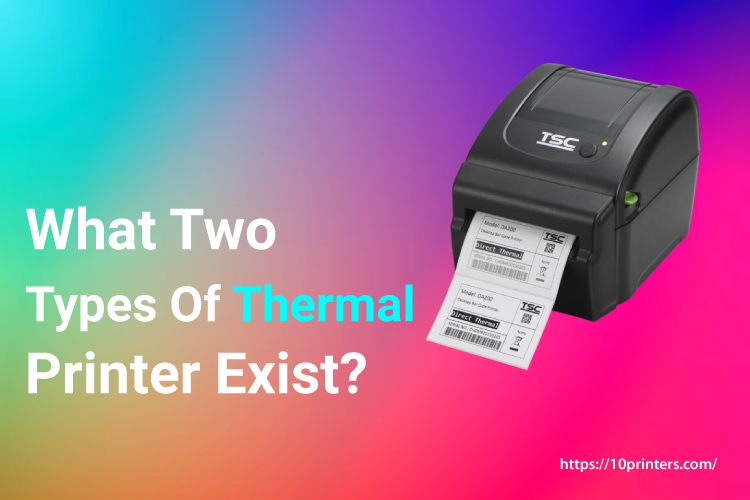Last Updated on October 11, 2022 by Jordi Hilpert
The printing industry has seen tremendous progress with thermal printers. Both thermal printers operate on the principle of high-quality printing.
So, what two types of thermal printer exist? Don’t worry. We’re here to help you understand the differences between different types of thermal printers. It is our hope that it will be of great benefit to you when dealing with thermal printers.
What is a Thermal Printer?
Digital printing is possible with a thermal printer. The printing process is quite different from traditional printers. To produce images on paper, this printer does not use ink or toner.
How does a thermal printer print?
This printer prints on thermal paper using an electric heater. This printer is cost-effective because it does not require ribbons or cartridges. It also includes printing software that can be used to edit images and improve print quality.
Its popularity in many fields is due to its noise-free service and fast monochromatic printing. The thermal printer is a popular choice for commercial, banking, and grocery offices.
What Two Types Of Thermal Printer Exist?
Two names are essential when you think about thermal printer types. These are
Thermal transfer printer
Direct thermal printer
These printers are well-known as thermal printers. Each printer has specific features that optimize thermal printing.
What are the differences between these types of thermal printers, you ask? How do these printers differ? Let’s dig it deeper.
1. Thermal Transfer Printer
A thermal transfer printer is composed of a thermal ribbon at the center of the printhead with a label. This printer, unlike direct thermal printers, supports the use of resin or wax ribbons.
This thermal printer can be used for multiple purposes. The heat-sensitive papers here are expensive and transparent. These films are excellent for thermal printing.
2. Direct Thermal Printer
Direct thermal printers can be used where label materials and printheads have direct attachments. These printers include the printheads that are used for heat generation. Direct thermal printers are able to print multiple colors at once, which is most notable.
They also have flexible ink ribbons, which allow these printers to change the colors of thermal paper. The principle of the printer is not conducive to reusing thermal paper.
The Main Parts of a Direct and Thermal Transfer Printer
Are you amused by the fact that these thermal printers offer high-class performance and are both affordable?
High-quality materials are used to make direct and thermal transfer printers. They are durable and highly functional, allowing for outstanding printing on thermal film.
What do you know about the main components of these printers, and how can they be used? Let’s take a look.
Electric Coil
This part produces heat in both thermal printers. An electric coil is used in direct thermal printers to heat the printheads and turn the thermal paper to black. This coil melts the wax using thermal transfer printers by heating it enough.
Printhead
The electric coil is contained in the printhead, which is an essential part. This regulates current conduction via the heating material. Multiple nozzles are included in the thermal printer’s printhead. Print speed is affected by the number of nozzles present in the printhead.
To get a better understanding of printheads, you can search “What is a Printhead on a Printer”
Memory
Thermal printers have a memory unit that supports the microcontroller, which processes data and runs programs. These services are usually provided by advanced thermal transfer and direct printers with SDRAM or DRAM.
Control Unit
Another name for the control unit is the microcontroller unit. It controls the nozzles and electric coils that ensure smooth printing. Besides, it stores graphics, dot matrix characters, etc.
These are the main components of thermal printers. These are the basic parts of thermal printers. Other than these, there is a display unit and an LED indicator. Spindle, Label cutter, spindle, etc.
Direct Thermal or Thermal Transfer Printers which one is better
As you see There are two main types of thermal printers, direct thermal and transfer. Both printers use the heat generated by electrical current/pulses within the printer’s print head.
Direct thermal printing is when the printer’s print head comes in direct contact with the material being printed onto (mostly specialized paper). The thermal reaction that causes the paper to change color or “print” is caused by the electrical pulses coming from the printer’s print head.
The print head of thermal transfer printing does not touch the material you are printing onto. Instead, a printer ribbon is placed between the print head of what you are printing onto and the print head. Thermal transfer printing uses a ribbon that runs across the printhead. The electrical current from the printer causes the material in the ribbon to transfer to the paper you are printing onto.
Direct thermal vs. thermal transfer can be described as “direct thermal printing vs. indirect thermal printing”. Direct thermal refers to direct contact between the printhead and the printed matter, while thermal transfer involves a ribbon being placed in between the printhead and the printed materials.
Thermal Label vs. Thermal Transfer
Thermal transfer and thermal label can sometimes be interchangeably used when talking about these types of printers. We want to clarify any confusion. Direct thermal printers are almost always the preferred choice for thermal label printers. Because they print directly onto labels, they are commonly called thermal labels. A thermal label can also be referred to as direct thermal printing.
Thermal transfer printers are also not designed to print directly on labels. They are best suited for more specific purposes like printing on heat shrink tubing. Learn more about the 10 Best Lightweight Handy Label Makers by visiting.
Direct Thermal vs. Thermal Transfer vs. Inkjet Printers
Direct thermal printers can be used to print things such as shipping labels and receipts. Although they require special paper, there are many options for printing shipping labels and receipts. Most people have an inkjet printer at home or at work. These printers are ideal for printing photos, graphics, and any other type of print that requires more detail and color.
Because ink can be difficult to work with, it is easy for inkjet printers to become maintenance issues. Ink cartridges must be calibrated and cleaned, and nozzles should be changed frequently. Smudges can also occur, which is undesirable for some types of printing. Although inkjet printers are able to print on most paper, they do not require special papers. However, different papers can produce different print results.
What if you need to print on something different from paper? Thermal transfer printers are the answer. Inkjet printers are not able to print on heat shrink, so direct thermal will not work.
These problems are solved by thermal transfer printers, which transfer the ribbon onto the heat shrink tubing. The ribbon is highly resistant to smudges. If you are looking for something special, such as putting labels on heat shrink, a thermal printer is the best choice.
Thermal transfer printers cannot transfer ribbons to any other material. Heat shrink tubing can be used as an example. However, not all heat shrink tubes are made from the same materials.
Thermal transfer printing is extremely specialized. Direct thermal printing is great to print shipping labels and receipts, while inkjet printing can be used for graphics and photos. Thermal transfer is also great for heat shrinking and other highly-specialized applications.
The application of your printer will determine the type of printer you choose. You will want the printer that is best suited for your application if you have a particular application in mind.
FAQ
What is Thermal Printing?
The unique technology of thermal printing is an innovative type of printing technology. Printheads are used to control the heat for printing on thermal papers.
Is a Zebra Printer a Thermal Printer?
Yes. You can find Zebra printers in both thermal transfer and direct thermal forms. Certain Zebra printers are capable of thermal printing.
What is the Difference Between Inkjet and Thermal Printers?
Thermoplastic printers use heat to replace ink. Inkjet printers work with ink controlled by the printhead. Inkjet printing takes longer than thermal printing. The thermal process is completely dry while inkjet printing is wet because of the used ink.
What is a Thermal Printer?
The thermal printer is a natural dot-matrix printing device. It prints images and text on thermal-sensitive film.
What are the Most Important Features of a Thermal Printer?
Print speed, resolution, and cost are the most important features of thermal printers.
What is the life expectancy of a thermal printer?
A thermal printer’s average life expectancy is between 8-10 years. You may then need to replace the printhead or continue printing.
Conclusion
These are the facts about thermal printers. We tried to simplify everything. We hope you find it useful. Keep checking back for more information about different printers.





